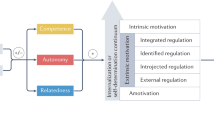Abstract
Features of the work environment can be designed to contain cues for performance standards, thereby influencing productivity on the job. This paper explores the importance of normative information for motivation and how it can be designed into the workplace in order to promote more efficient job behaviors.
Similar content being viewed by others
References
Davis, T.R.V. (1984). The influence of the physical environment in offices.Academy of Management Review, 9, 183–271.
Davis, T.R.V. and Luthans, F. (1980). Managers in action: A new look at their behavior and operating modes.Organizational Dynamics, 9, 64–80.
Fiske, S.T., Kenny, D.A., and Taylor, S.E. (1982). Structural models for the mediation of salience effects on attribution.Journal of Experimental Social Psychology,18.
Ford, J.K. (1983).The impact of goal setting and self monitoring on the accuracy of self generated knowledge of results and the level of task performance. Unpublished doctoral dissertation, Ohio State University.
Griffin, R.W. (1983). Objective and social sources of information in task redesign: A field experiment.Administrative Science Quarterly, 28, 184–200.
Herzlinger, R. E. and Schwartz, J. (1986). How companies tackle health care costs: Part III.Harvard Business Review, January–February 70–80.
Komaki, J., Barwick, K., and Scott, L. (1978). A behavioral approach to occupational safety: Pinpointing and reinforcing safe performance in a food manufacturing plant.Journal of Applied Psychology, 63, 434–445.
Mayo, E. (1933).The human problems in an industrial civilization. New York: Macmillan.
McArthur, L.Z. and Post. D.L. (1977). Figured emphasis and person perception.Journal of Experimental Social Psychology, 13, 520–535.
Mitchell, T.R. (1982). Motivation: New directions for theory, research, and practice.Academy of Management Review, 7, 80–85.
Mitchell, T.R., Rothman, M. and Liden, R.C. (1985). The effects of normative information on task performance.Journal of Applied Psychology, 70, 48–55.
Nisbett, R.E. and Wilson, T. (1977). Telling more then we can know: Verbal reports on mental processes.Psychological Review, 84, 231–252.
Pennebaker, J.W. and Lightner, J.M. (1980). Competition of internal and external information in an exercise setting.Journal of Personality and Social Psychology, 39, 165–174.
Porter, L.W., Lawler, E.E. and Hackman, J.R. (1975).Behavior in organizations, New York: McGraw Hill.
Rajecki, D.W., Ickes, W., Corcoran, C., and Lenerz, K. (1977). Social facilitation of human performance: Mere presence effects.Journal of Social Psychology, 102, 297–310.
Rakestraw, T.L. and Weiss, H.M. (1981). The interaction of social influence and task experience on goals, performance and performance satisfaction.Organizational behavior and human performance, 27, 326–344.
Salancik, G., and Pfeffer, J. (1978). A social information processing approach to job attitudes and task design.Administrative Science Quarterly, 23, 224–250.
Scheier, M.F. and Carver, C.S. (1983). Self-directed attention and the comparison of self with standards.Journal of Experimental Social Psychology, 19, 205–222.
Taylor, S.E. and Fiske, S.T. (1978). Salience, attention and attributions: Top of the head phenomenon. In L. Berkowitz (Ed.),Advances in experimental social psychology, Vol. 2, New York: Academic Press.
Tversky, A. and Kaheman, D. (1974). Judgement under uncertainty: Heiristics and biases.Science, 185, 1124–1131.
White, S.E. and Mitchell, T.R. (1979). Job enrichment versus social cues: A comparison and competitive test.Journal of Applied Psychology, 64, 1–9.
Author information
Authors and Affiliations
Additional information
The author gratefully acknowledges the helpful comments of Terence R. Mitchell and J.H. Kerr Inkson on an earlier draft of this paper.
Rights and permissions
About this article
Cite this article
Rothman, M. Designing work environments to influence productivity. J Bus Psychol 1, 390–395 (1987). https://doi.org/10.1007/BF01018147
Issue Date:
DOI: https://doi.org/10.1007/BF01018147




